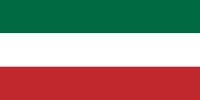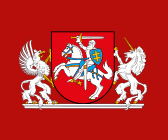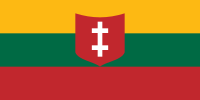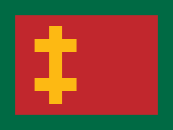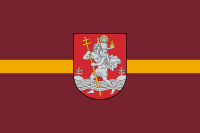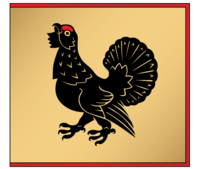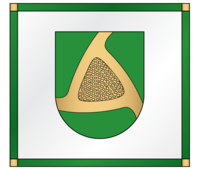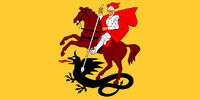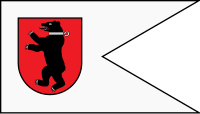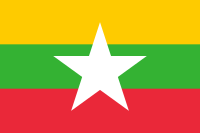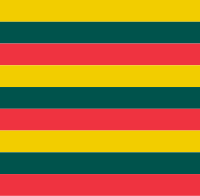Flag of Lithuania
| Flag of Lithuania | |
|---|---|
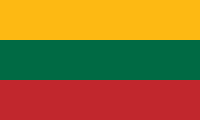 |
|
| Vexillological symbol : |
|
| Aspect ratio: | 3: 5 |
| Officially accepted: | First: April 19, 1918 Reintroduced: March 20, 1989 Aspect ratio since: September 1, 2004 |
The flag of Lithuania is a tricolor with three horizontal stripes of yellow, green, and red.
Description and meaning
The three colors symbolize the Lithuanian values: yellow stands for sun, light and goodness, green means nature, freedom and hope, red is the land, courage and the blood that was shed for the homeland.
| colour | yellow | green | red |
|---|---|---|---|
| Pantone | 15-0955 TP / 1235 c / u | 19-6026 TP / 349 c / u | 19-1664 TP / 180 c / u |
| RGB | 253-185-19 | 0-106-68 | 193-39-45 |
| CMYK | 0-30-100-0 | 100-55-100-0 | 25-100-100-0 |
history
The first description of Lithuanian flags comes from a description of the Battle of Tannenberg , in which an army of the Teutonic Order met a combined force of the Polish King Władysław II Jagiełło and the Lithuanian Grand Duke Vytautas . According to the chronicle of Jan Dlugosz, 30 Lithuanian regiments led the Vytis a white knight on a red background who seems to be chasing an enemy. Ten regiments carried the pillars of Gediminas , a white, stylized castle on a red background , as a standard .
The Vytis, as found in the Lithuanian national coat of arms, was first found in 1366 in the seal of Algirdas , the Grand Duke of Lithuania. The columns of Gediminas are the coat of arms of the Gediminas dynasty, which presented the Grand Dukes of Lithuania from 1316. The regiments under this standard were probably those from the home of the Grand Duke, while the other troops showed the Vytis as a symbol of the Grand Duchy. The Vytis on a red background was used until the end of the 18th century as the flag of the Grand Duke, the Empire, as a war flag and ultimately as a symbol of Lithuania.
With the French Revolution, tricolors became popular. The traditional Lithuanian colors were white and green, and those of the Vytis flag were red and white. Thus red, white and green offered themselves as national colors. It was used from 1829 by Lithuanian students at the University of Königsberg and from 1885 by the Birute Society . This color combination was not popular, however, as it was also common in East Prussian Lithuania Minor . For this reason, flags were often shown with red and green separated by a narrow yellow stripe. After the declaration of independence in 1918, a commission was set up to draft a national flag. Since this commission, consisting of Jonas Basanavičius, Tadas Daugirdas and Antanas Žmuidzinavičius, carmine red and dark green seemed too dreary, it added the yellow stripe after long deliberations. The aspect ratio chosen was 2: 3. From the mid-1920s, red and green were displayed lighter. The flag of Lithuania Minor continued to be used as the flag of the Memel District between 1920 and 1939 .
In 1940 the Soviet Union annexed the Baltic States . As a Soviet republic, Lithuania initially received a flag corresponding to that of the Soviet Union with its initials. In 1953, the design of all flags of the Soviet republics was changed and Lithuania was given a Soviet flag with a narrow white and a wide green stripe at the bottom and the hammer and sickle symbol and a red star on the front of the flag. The flag of the Tajik SSR was similar, but had a red stripe below the green one.
On March 20, 1989, the old yellow-green-red flag in the proportions 1: 2 was officially adopted again. These were changed to 3: 5 by law on September 1, 2004.
 ? Lithuania Minor since 1660
? Lithuania Minor since 1660
2: 3 ? Flag of Lithuania 1918-1940

1: 2 ? Flag of the Lithuanian SSR 1940–1953

1: 2 ? Flag of the Lithuanian SSR 1953-1989


1: 2 ? Flag of the Lithuanian SSR, back side


1: 2 ? Flag of Lithuania 1989-2004

3: 5 ? Flag of Lithuania since 2004

Flags of the state
With the new flag law, a red flag with the Vytis was introduced as the state flag. It corresponds to the state flag that was in use before the Second World War. The flag is displayed on certain historic buildings and on public holidays:
- February 16: Day of the Restoration of the State of Lithuania, 1918
- March 11: Lithuanian Independence Restoration Day 1990
- July 6th: State Day
- July 15th: Day of the Battle of Žalgiris
- October 25: Constitution Day
On January 26, 1993, the President of Lithuania was awarded its own flag by the Seimas , which is the symbol of the head of state. According to Article 12 of the Law on the Office of the President, the flag is “purple” (dark red is meant here) and shows the state emblem in the center, which is carried by a griffin on the right and a unicorn on the left. The aspect ratio is 5: 6. The flag is planted on the president's residence when he is in the capital Vilnius and on the summer residence when he is in the town. Ships and other vehicles with the President on board also display his flag.
The state flag and the flag of the president were identical before the Second World War, but had a different front and back. On the front it showed the Vytis, on the back the white Gediminas symbol.
 ? State flag since 2004
? State flag since 2004
2: 3 ? State and presidential flags before World War II, front side


2: 3 ? back


Military flags
The naval flag of Lithuania is based on the British White Ensign . On a white background there is a blue George Cross with the Lithuanian tricolor in the jack . The aspect ratio is 1: 2. With an aspect ratio of 2: 3, the Kaunas Yacht Club KYC used the same flag before World War II . At that time the Lithuanian tricolor flag was used as the naval war flag with a red shield in the center, which was covered with a white Vytis cross. The aspect ratio was 1: 2, for the state flag at sea a version with 2: 3 was used.
The currently used Gösch corresponds to the national flag of Lithuania. Before WWII it was a red flag with a green border and a yellow Vytis cross in the leech . In the period after 1992, a white flag with a blue anchor that shows the yellow Gediminas symbol on a red disk was initially used. These were abandoned between 2001 and 2008 in favor of the current flag.
1: 2 ? Naval war flag

Jack of the Navy (corresponds to the state flag)
1: 2 ? Naval war flag between world wars


 ? Gösch of the navy between the world wars
? Gösch of the navy between the world wars
 ? Gösch of the Navy after 1992
? Gösch of the Navy after 1992
Subnational flags of Lithuania
Municipal flags
Examples of Lithuanian municipal flags. They usually take the municipal coat of arms as a template.
Historic landscapes of Lithuania
Samogitia ( Žemaitėjė ) is a historical landscape in the northwest of today's Lithuania. In the Middle Ages it enjoyed extensive autonomy. Her flag was white with a swallowtail that bore her bear crest. A political movement calling for Samogetian autonomy in what is now Lithuania, published a newer draft version in 2008. Also Upper Lithuania ( Aukschtaitien ) has an unofficial flag, which shows his coat of arms and two label support on a red background.
Similar flags
The national flag of Myanmar , introduced in 2010, has the same color scheme as the flag of Lithuania, but is distinguished by a white star in the middle. The design goes back to older flags from the 1940s, there are no cultural or historical connections to Lithuania. The unofficial flag of the Danish island of Ærø resembles the Lithuanian flag, except for marginal variations in color.
4: 7 ? Flag of Myanmar since 2010

See also
Web links
- Flags of the World - Lithuania (English)
Individual evidence
- ↑ a b c Website of the Seimas: The Lithuanian State flag (English)
- ^ Flags of the World - Lithuania - Coat of Arms
- ↑ REPUBLIC OF LITHUANIA: LAW ON THE OFFICE OF PRESIDENT, January 26, 1993 No. I-56 Vilnius (English)
- ^ Flags of the World - State Flag, President of the Republic and State Ensign
- ^ Flags of the World - Yacht Club Kaunas
- ↑ Flags of the World - https://flagspot.net/flags/lt~1920.html
- ↑ Flags of the World - Samogitia (Lithuania)
- ↑ Flags of the World - https://flagspot.net/flags/lt_auko.html




